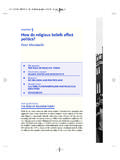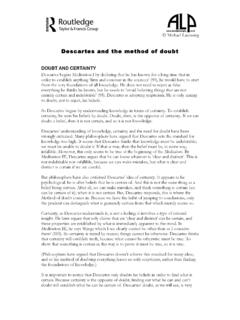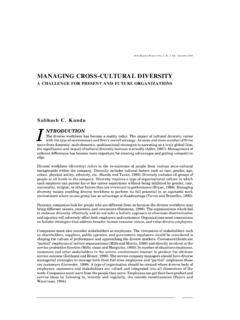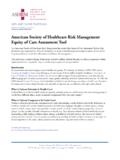Transcription of TRANSLATION THEORY AND TRANSLATION QUALITY …
1 1 TRANSLATION THEORY AND TRANSLATION QUALITY ASSESSMENTIn this introductory chapter I will brief ly explain what I take TRANSLATION to be, and also introduce topics that will be treated in more detail in the following is both a cognitive procedure which occurs in a human being s, the translator s, head, and a social, cross-linguistic and cross-cultural practice. Any valid THEORY of TRANSLATION must embrace these two aspects. To do this, a multidisciplinary approach to TRANSLATION THEORY integrating these aspects in a plausible manner is needed. Further, a THEORY of TRANSLATION is not possible without a ref lection on the role of one of its core concepts: equivalence in TRANSLATION . And looking at equivalence leads directly into a discussion of how one would go about assessing the QUALITY of a TRANSLATION .
2 TRANSLATION QUALITY assessment can thus be said to be at the heart of any THEORY of TRANSLATION . This book is a new treatment of TRANSLATION QUALITY assessment designed to update my two previous versions of a model for TRANSLATION QUALITY assessment (House 1977, 1997). Since to my knowledge this model is today still the only fully worked out, research-based, theoretically informed and interdisciplinary conceived approach to TRANSLATION QUALITY assessment of its kind, I believe it is now time to present an updated version of the model particularly in view of the enormous growth and spread of TRANSLATION studies in recent decades, as well as a soaring interest in TRANSLATION QUALITY assessment in the TRANSLATION profession and the TRANSLATION this volume includes a detailed description of my own work in the fields of cross-cultural and intercultural research, and TRANSLATION evaluation over the past 40 years, I will also provide a review of a number of interesting and relevant approaches.
3 Detailing their relative merits and limitations. I will look both into past attempts at evaluating translations and into a number of present day research strands that might prove useful for validating judgements about the Copyrighted material - Provided by Taylor & Francis 2 TRANSLATION THEORY and TRANSLATION QUALITY assessmentworth of a TRANSLATION , among them work on contrastive pragmatics and intercultural communication, corpus studies and psycho-neuro- and cognitive linguistic research. I will argue for the necessity in TRANSLATION studies of a multidisciplinary view of TRANSLATION that combines traditional linguistically informed and text-based views of TRANSLATION with views that emphasize the context of TRANSLATION in its widest sense taking account of power relations, conf lict situations, ethical issues and the human beings involved in acts of TRANSLATION , authors, translators, readers, and so on (see my recent edited volume, House 2014).
4 In recent decades, we have witnessed a rather one-sided shift in the field of TRANSLATION studies towards viewing TRANSLATION as a predominantly social, cultural, political, ethical and ideology-dominated affair. While such concerns are of course necessary and valuable, one should not forget that TRANSLATION is, at its core, a linguistic act. So while on the whole maintaining a stance which is as fair, balanced and non-biased as possible, I will try in this book to emphasize the importance of detailed textual analysis and comparison, since this is the strength of my model of TRANSLATION QUALITY assessment . And in my view TRANSLATION QUALITY assessment means both retrospectively assessing the worth of a TRANSLATION and prospectively ensuring the QUALITY in the production of a is TRANSLATION ?
5 TRANSLATION can be defined as the result of a linguistic-textual operation in which a text in one language is re-contextualized in another language. As a linguistic-textual operation, TRANSLATION is, however, subject to, and substantially inf luenced by, a variety of extra-linguistic factors and conditions. It is this interaction between inner linguistic-textual and outer extra-linguistic, contextual factors that makes TRANSLATION such a complex phenomenon. Some of the interacting factors we need to consider when looking at TRANSLATION are: the structural characteristics, the expressive potential and the constraints of the two languages involved in TRANSLATION ; the extra-linguistic world which is cut up in different ways by source and target languages; the source text with its linguistic-stylistic-aesthetic features that belong to the norms of usage holding in the source lingua-cultural community; the linguistic-stylistic-aesthetic norms of the target lingua-cultural community; the target language norms internalized by the translator; intertextuality governing the totality of the text in the target culture; traditions, principles, histories and ideologies of TRANSLATION holding in the target lingua-cultural community.
6 The translational brief given to the translator by the person(s) or institution commissioning the TRANSLATION ; Copyrighted material - Provided by Taylor & Francis TRANSLATION THEORY and TRANSLATION QUALITY assessment 3 the translator s workplace conditions; the translator s knowledge, expertise, ethical stance and attitudinal profiles as well as her subjective THEORY of TRANSLATION ; the TRANSLATION receptors knowledge, expertise, ethical stance and attitudinal profiles of the translator as well as their subjective theories of while TRANSLATION is, as stated above, at its core a linguistic-textual operation, a multitude of other conditioning and constraining factors also routinely impinge on its processes, performance and of course on TRANSLATION QUALITY . However, it is well nigh impossible for any practicable model of TRANSLATION QUALITY assessment to take into account all of these factors, much less so in an essentially text-based model such as my own.
7 So, I would maintain that despite the multiple conditioning of TRANSLATION and the resulting complexity, one may still, as a common core, retain the minimal definition of TRANSLATION as a replacement of an original text in one language with a text in another language. When using the term replacement , one may assume, rather negatively, that any translated text is in principle second-best , a substitute for the real thing . Viewed this way, TRANSLATION is by definition a secondary act of communication. Normally, a communicative event happens only once. In TRANSLATION , this communicative event is reduplicated for persons or groups otherwise prevented from appreciating the original communicative event. More positively, however, TRANSLATION can be seen as enabling often for the first time original access to a different world of knowledge, to different traditions and ideas that would otherwise have been locked away behind a language barrier.
8 From this perspective, TRANSLATION has often been described as a builder of bridges, an extender of horizons, providing recipients with an important service and enabling them to move beyond the borders of the world staked out by their own language. It is through TRANSLATION that lingua-cultural barriers can be overcome. So TRANSLATION is one of the most important mediators between societies and cultures. But despite all these assets, it remains a fact that TRANSLATION only gives readers access to a message which already exists. This inherently derived nature of TRANSLATION also means that, in TRANSLATION , there is always both an orientation backwards to the existing previous message of the original text and an orientation forwards towards how texts in a corresponding genre are composed in the target language.
9 This type of double-bind relationship is a basic characteristic of TRANSLATION which should not be forgotten. TRANSLATION as intercultural communication and social action As mentioned above, TRANSLATION is not only a linguistic act, it is also an act of communication across cultures. This was recognized in the sixties by one of the grand figures of TRANSLATION THEORY : Eugene Nida. Nida (1964) saw TRANSLATION as one of the major means of constructing representations of other cultures. He clearly recognized that TRANSLATION always involves both different languages and Copyrighted material - Provided by Taylor & Francis 4 TRANSLATION THEORY and TRANSLATION QUALITY assessmentdifferent cultures simply because the two cannot be neatly separated. Language is culturally embedded: it serves to express and shape cultural reality, and the meanings of linguistic units can only be understood when considered together with the cultural contexts in which they arise, and in which they are used.
10 In TRANSLATION , therefore, not only two languages but also two cultures invariably come into contact. In this sense, then, TRANSLATION is a form of intercultural communication. Over and above recognizing the importance of the two larger macro-cultural frameworks, however, the translator must of course also consider the more immediate context of situation . This more local situational context has to do with questions about who wrote the text, when, why, for whom, and who is now reading it, and for what purpose, etc. These questions, in turn, are ref lected in how a text is written, interpreted, read and used. The context of situation is itself embedded in the larger socio-cultural world as it is depicted in the text and in the real world. The inherently ref lective nature of translational action reveals itself in a translator s focus on the situatedness of a text, and his or her recognition of the intimate interconnectedness of text and context.
















